[English] 日本語
 Yorodumi
Yorodumi- PDB-7rto: Cryo-EM structure of bluetongue virus capsid protein VP5 at low e... -
+ Open data
Open data
- Basic information
Basic information
| Entry | Database: PDB / ID: 7rto | |||||||||||||||||||||||||||
|---|---|---|---|---|---|---|---|---|---|---|---|---|---|---|---|---|---|---|---|---|---|---|---|---|---|---|---|---|
| Title | Cryo-EM structure of bluetongue virus capsid protein VP5 at low endosomal pH intermediate state 2 | |||||||||||||||||||||||||||
 Components Components | Outer capsid protein VP5 | |||||||||||||||||||||||||||
 Keywords Keywords | VIRAL PROTEIN / Bluetongue virus / capsid / membrane penetration / VP5 | |||||||||||||||||||||||||||
| Function / homology | Outer capsid protein VP5, Orbivirus / Orbivirus outer capsid protein VP5 / viral outer capsid / symbiont entry into host cell via permeabilization of host membrane / structural molecule activity / Outer capsid protein VP5 Function and homology information Function and homology information | |||||||||||||||||||||||||||
| Biological species |  Bluetongue virus Bluetongue virus | |||||||||||||||||||||||||||
| Method | ELECTRON MICROSCOPY / single particle reconstruction / cryo EM / Resolution: 3.8 Å | |||||||||||||||||||||||||||
 Authors Authors | Xia, X. / Wu, W.N. / Cui, Y.X. / Roy, P. / Zhou, Z.H. | |||||||||||||||||||||||||||
| Funding support |  United States, 1items United States, 1items
| |||||||||||||||||||||||||||
 Citation Citation |  Journal: Nat Microbiol / Year: 2021 Journal: Nat Microbiol / Year: 2021Title: Bluetongue virus capsid protein VP5 perforates membranes at low endosomal pH during viral entry. Authors: Xian Xia / Weining Wu / Yanxiang Cui / Polly Roy / Z Hong Zhou /   Abstract: Bluetongue virus (BTV) is a non-enveloped virus and causes substantial morbidity and mortality in ruminants such as sheep. Fashioning a receptor-binding protein (VP2) and a membrane penetration ...Bluetongue virus (BTV) is a non-enveloped virus and causes substantial morbidity and mortality in ruminants such as sheep. Fashioning a receptor-binding protein (VP2) and a membrane penetration protein (VP5) on the surface, BTV releases its genome-containing core (VP3 and VP7) into the host cell cytosol after perforation of the endosomal membrane. Unlike enveloped ones, the entry mechanisms of non-enveloped viruses into host cells remain poorly understood. Here we applied single-particle cryo-electron microscopy, cryo-electron tomography and structure-guided functional assays to characterize intermediate states of BTV cell entry in endosomes. Four structures of BTV at the resolution range of 3.4-3.9 Å show the different stages of structural rearrangement of capsid proteins on exposure to low pH, including conformational changes of VP5, stepwise detachment of VP2 and a small shift of VP7. In detail, sensing of the low-pH condition by the VP5 anchor domain triggers three major VP5 actions: projecting the hidden dagger domain, converting a surface loop to a protonated β-hairpin that anchors VP5 to the core and stepwise refolding of the unfurling domains into a six-helix stalk. Cryo-electron tomography structures of BTV interacting with liposomes show a length decrease of the VP5 stalk from 19.5 to 15.5 nm after its insertion into the membrane. Our structures, functional assays and structure-guided mutagenesis experiments combined indicate that this stalk, along with dagger domain and the WHXL motif, creates a single pore through the endosomal membrane that enables the viral core to enter the cytosol. Our study unveils the detailed mechanisms of BTV membrane penetration and showcases general methods to study cell entry of other non-enveloped viruses. | |||||||||||||||||||||||||||
| History |
|
- Structure visualization
Structure visualization
| Movie |
 Movie viewer Movie viewer |
|---|---|
| Structure viewer | Molecule:  Molmil Molmil Jmol/JSmol Jmol/JSmol |
- Downloads & links
Downloads & links
- Download
Download
| PDBx/mmCIF format |  7rto.cif.gz 7rto.cif.gz | 166.8 KB | Display |  PDBx/mmCIF format PDBx/mmCIF format |
|---|---|---|---|---|
| PDB format |  pdb7rto.ent.gz pdb7rto.ent.gz | 124.2 KB | Display |  PDB format PDB format |
| PDBx/mmJSON format |  7rto.json.gz 7rto.json.gz | Tree view |  PDBx/mmJSON format PDBx/mmJSON format | |
| Others |  Other downloads Other downloads |
-Validation report
| Summary document |  7rto_validation.pdf.gz 7rto_validation.pdf.gz | 1.1 MB | Display |  wwPDB validaton report wwPDB validaton report |
|---|---|---|---|---|
| Full document |  7rto_full_validation.pdf.gz 7rto_full_validation.pdf.gz | 1.1 MB | Display | |
| Data in XML |  7rto_validation.xml.gz 7rto_validation.xml.gz | 28.9 KB | Display | |
| Data in CIF |  7rto_validation.cif.gz 7rto_validation.cif.gz | 43.6 KB | Display | |
| Arichive directory |  https://data.pdbj.org/pub/pdb/validation_reports/rt/7rto https://data.pdbj.org/pub/pdb/validation_reports/rt/7rto ftp://data.pdbj.org/pub/pdb/validation_reports/rt/7rto ftp://data.pdbj.org/pub/pdb/validation_reports/rt/7rto | HTTPS FTP |
-Related structure data
| Related structure data |  24685MC  7rtnC C: citing same article ( M: map data used to model this data |
|---|---|
| Similar structure data |
- Links
Links
- Assembly
Assembly
| Deposited unit | 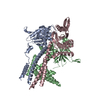
|
|---|---|
| 1 |
|
- Components
Components
| #1: Protein | Mass: 59070.371 Da / Num. of mol.: 3 / Source method: isolated from a natural source Source: (natural)  Bluetongue virus (serotype 1 / isolate South Africa) Bluetongue virus (serotype 1 / isolate South Africa)References: UniProt: K7QP12 Has protein modification | N | |
|---|
-Experimental details
-Experiment
| Experiment | Method: ELECTRON MICROSCOPY |
|---|---|
| EM experiment | Aggregation state: PARTICLE / 3D reconstruction method: single particle reconstruction |
- Sample preparation
Sample preparation
| Component | Name: Bluetongue virus (serotype 1 / isolate South Africa) / Type: VIRUS Details: The virus was generated from BHK-21 cell and purified by sucrose gradient. Entity ID: all / Source: NATURAL |
|---|---|
| Molecular weight | Units: MEGADALTONS / Experimental value: NO |
| Source (natural) | Organism:  Bluetongue virus (serotype 1 / isolate South Africa) Bluetongue virus (serotype 1 / isolate South Africa)Strain: BTV-1 |
| Details of virus | Empty: YES / Enveloped: NO / Isolate: SPECIES / Type: VIRION |
| Natural host | Organism: sheep |
| Virus shell | Diameter: 880 nm |
| Buffer solution | pH: 5.5 |
| Buffer component | Conc.: 20 mM / Name: sodium citrate |
| Specimen | Embedding applied: NO / Shadowing applied: NO / Staining applied: NO / Vitrification applied: YES |
| Specimen support | Grid material: COPPER / Grid mesh size: 400 divisions/in. / Grid type: PELCO Ultrathin Carbon with Lacey Carbon |
| Vitrification | Instrument: FEI VITROBOT MARK IV / Cryogen name: ETHANE / Humidity: 100 % |
- Electron microscopy imaging
Electron microscopy imaging
| Experimental equipment |  Model: Titan Krios / Image courtesy: FEI Company |
|---|---|
| Microscopy | Model: FEI TITAN KRIOS |
| Electron gun | Electron source:  FIELD EMISSION GUN / Accelerating voltage: 300 kV / Illumination mode: FLOOD BEAM FIELD EMISSION GUN / Accelerating voltage: 300 kV / Illumination mode: FLOOD BEAM |
| Electron lens | Mode: BRIGHT FIELD / Nominal magnification: 105000 X / Cs: 2.7 mm / C2 aperture diameter: 50 µm / Alignment procedure: BASIC |
| Specimen holder | Cryogen: NITROGEN / Specimen holder model: FEI TITAN KRIOS AUTOGRID HOLDER |
| Image recording | Average exposure time: 8 sec. / Electron dose: 50 e/Å2 / Detector mode: SUPER-RESOLUTION / Film or detector model: GATAN K2 SUMMIT (4k x 4k) / Num. of grids imaged: 1 / Num. of real images: 3609 |
| EM imaging optics | Energyfilter name: GIF Quantum LS / Energyfilter slit width: 20 eV |
- Processing
Processing
| Software | Name: PHENIX / Version: 1.19.2_4158: / Classification: refinement | ||||||||||||||||||||||||
|---|---|---|---|---|---|---|---|---|---|---|---|---|---|---|---|---|---|---|---|---|---|---|---|---|---|
| EM software |
| ||||||||||||||||||||||||
| CTF correction | Type: PHASE FLIPPING ONLY | ||||||||||||||||||||||||
| Particle selection | Num. of particles selected: 913440 | ||||||||||||||||||||||||
| Symmetry | Point symmetry: C1 (asymmetric) | ||||||||||||||||||||||||
| 3D reconstruction | Resolution: 3.8 Å / Resolution method: FSC 0.143 CUT-OFF / Num. of particles: 103469 / Num. of class averages: 1 / Symmetry type: POINT | ||||||||||||||||||||||||
| Atomic model building | Protocol: OTHER | ||||||||||||||||||||||||
| Atomic model building | PDB-ID: 3J9E Accession code: 3J9E / Source name: PDB / Type: experimental model | ||||||||||||||||||||||||
| Refine LS restraints |
|
 Movie
Movie Controller
Controller








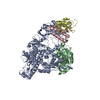

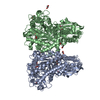
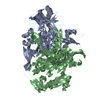
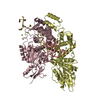
 PDBj
PDBj

